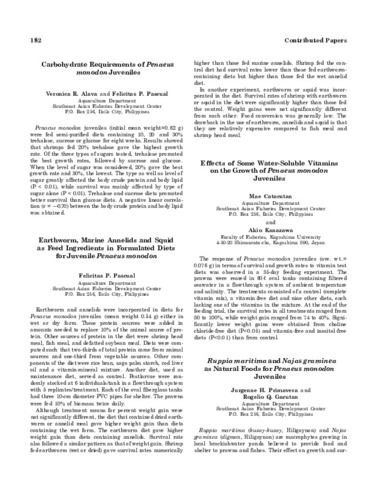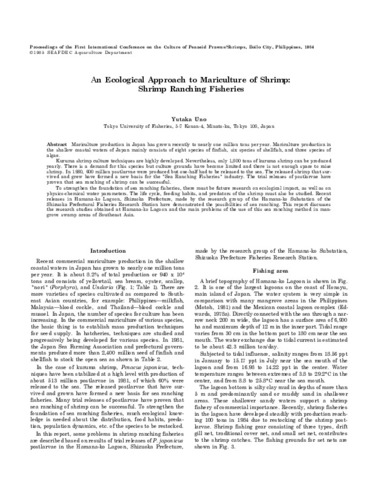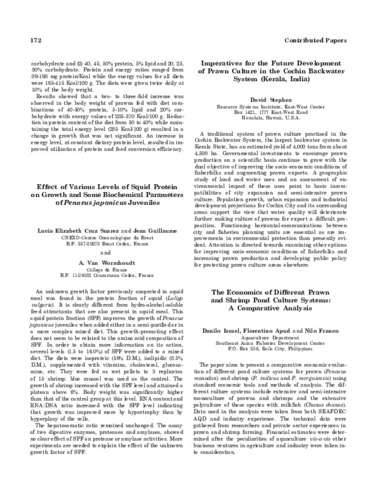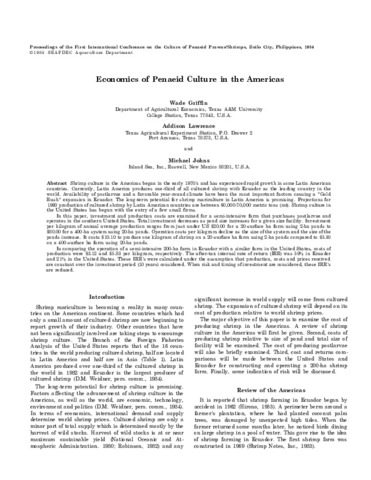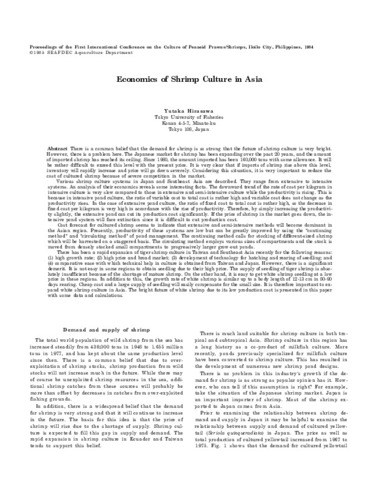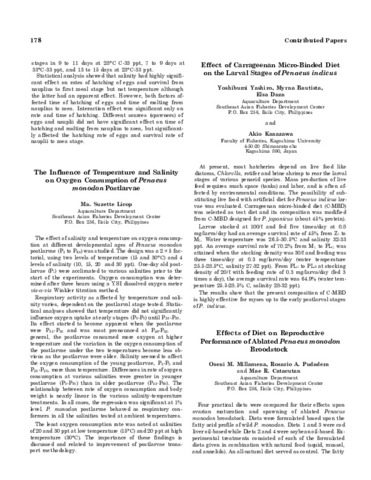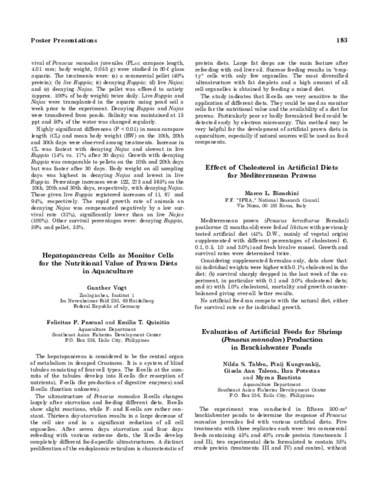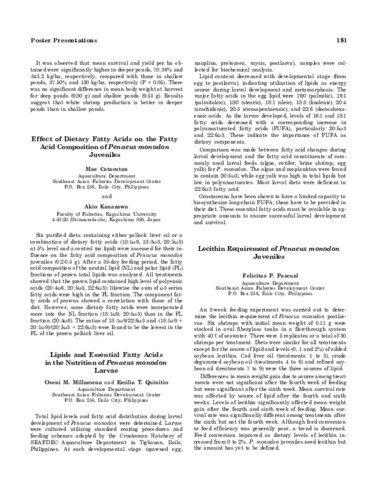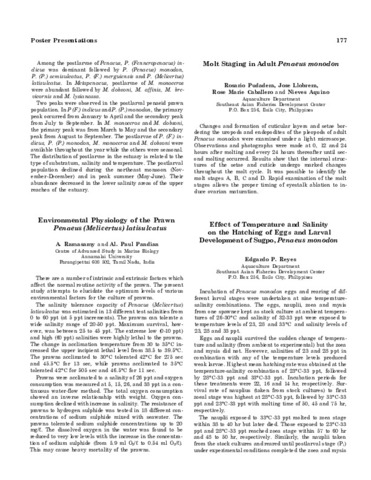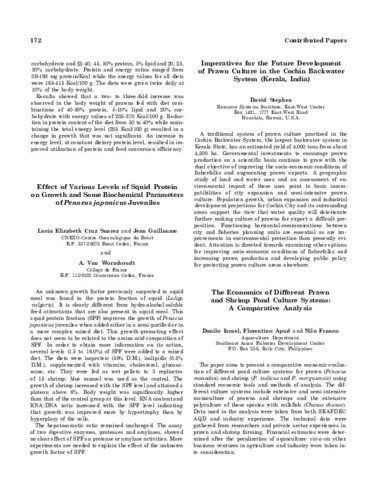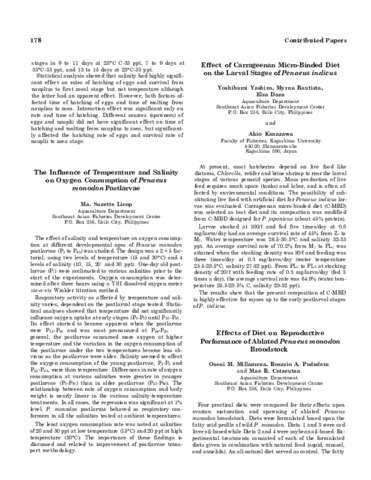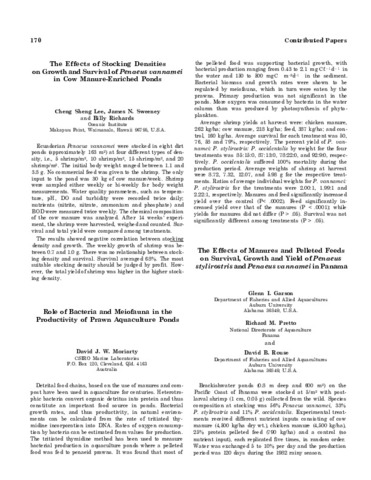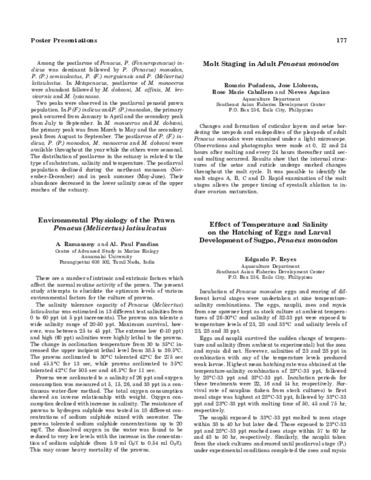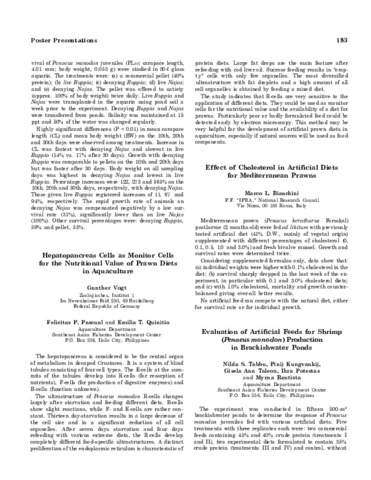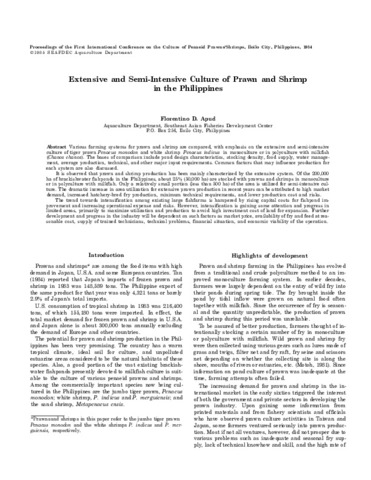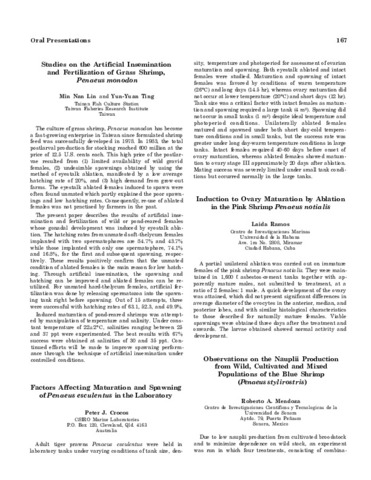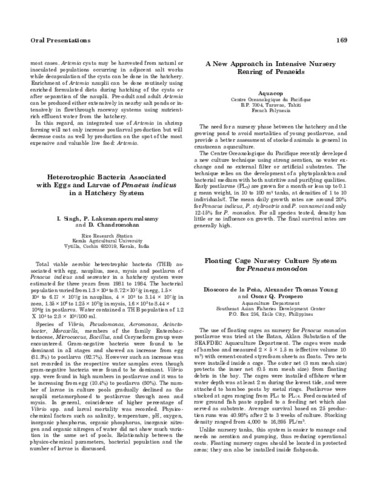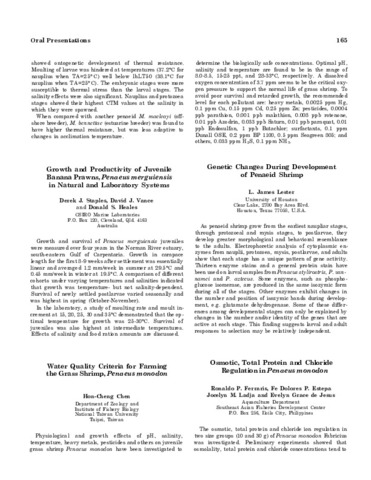Browsing Proceedings of the First International Conference on the Culture of Penaeid Prawns/Shrimps by Title
Now showing items 12-31 of 79
-
Earthworm, marine annelids and squid as feed ingredients in formulated diets for juvenile Penaeus monodon
(Aquaculture Department, Southeast Asian Fisheries Development Center, 1985)Earthworm and annelids were incorporated in diets for Penaeus monodon juveniles (mean weight 0.54 g) either in wet or dry form. These protein sources were added in amounts needed to replace 10% of the animal source of ... -
An ecological approach to mariculture of shrimp: Shrimp ranching fisheries
(Aquaculture Department, Southeast Asian Fisheries Development Center, 1985)Mariculture production in Japan has grown recently to nearly one million tons per year. Mariculture production in the shallow coastal waters of Japan mainly consists of eight species of finfish, six species of shellfish, ... -
The economics of different prawn and shrimp pond culture systems: A comparative analysis
(Aquaculture Department, Southeast Asian Fisheries Development Center, 1985)The paper aims to present a comparative economic evaluation of different pond culture systems for prawn (Penaeus monodon) and shrimp (P. indicus and P. merguiensis) using standard economic tools and methods of analysis. ... -
Economics of penaeid culture in the Americas
(Aquaculture Department, Southeast Asian Fisheries Development Center, 1985)Shrimp culture in the Americas began in the early 1970's and has experienced rapid growth in some Latin American countries. Currently, Latin America produces one-third of all cultured shrimp with Ecuador as the leading ... -
Economics of shrimp culture in Asia
(Aquaculture Department, Southeast Asian Fisheries Development Center, 1985)There is a common belief that the demand for shrimp is so strong that the future of shrimp culture is very bright. However, there is a problem here. The Japanese market for shrimp has been expanding over the past 20 years, ... -
Effect of carrageenan micro-binded diet on the larval stages of Penaeus indicus
(Aquaculture Department, Southeast Asian Fisheries Development Center, 1985)At present, most hatcheries depend on live food like diatoms, Chlorella, rotifer and brine shrimp to rear the larval stages of various penaeid species. Mass production of live feed requires much space (tanks) and labor, ... -
Effect of cholesterol in artificial diets for Mediterranean prawns
(Aquaculture Department, Southeast Asian Fisheries Development Center, 1985)Mediterranean prawn (Penaeus kerathurus Forsskal) postlarvae (2 months old) were fed ad libitum with previously tested artificial diet (41% D.W., mainly of vegetal origin) supplemented with different percentages of cholesterol ... -
Effect of dietary fatty acids on the fatty acid composition of Penaeus monodon juveniles
(Aquaculture Department, Southeast Asian Fisheries Development Center, 1985)Six purified diets containing either pollack liver oil or a combination of dietary fatty acids (18:1ω9, 18:3ω3, 20:5ω3) at 5% level and a control (no lipid) were assessed for their influence on the fatty acid composition ... -
Effect of temperature and salinity on the hatching of eggs and larval development of sugpo, Penaeus monodon
(Aquaculture Department, Southeast Asian Fisheries Development Center, 1985)Incubation of Penaeus monodon eggs and rearing of different larval stages were undertaken at nine temperature-salinity combinations. The eggs, nauplii, zoea and mysis from one spawner kept as stock culture at ambient ... -
Effect of various levels of squid protein on growth and some biochemical parameters of Penaeus japonicus juveniles
(Aquaculture Department, Southeast Asian Fisheries Development Center, 1985)An unknown growth factor previously suspected in squid meal was found in the protein fraction of squid (Loligo vulgaris). It is clearly different from hydro-alcohol-soluble feed attractants that are also present in squid ... -
Effects of diet on reproductive performance of ablated Penaeus monodon broodstock
(Aquaculture Department, Southeast Asian Fisheries Development Center, 1985)Four practical diets were compared for their effects upon ovarian maturation and spawning of ablated Penaeus monodon broodstock. Diets were formulated based upon the fatty acid profile of wild P. monodon. Diets 1 and 3 ... -
The effects of manures and pelleted feeds on survival, growth and yield of Penaeus stylirostris and Penaeus vannamei in Panama
(Aquaculture Department, Southeast Asian Fisheries, Development Center, 1985)Brackishwater ponds (0.8 m deep and 600 m2) on the Pacific Coast of Panama were stocked at 5/m2 with post-larval shrimp (1 cm, 0.05 g) collected from the wild. Species composition at stocking was 56% Penaeus vannamei, 33% ... -
Effects of some water-soluble vitamins on the growth of Penaeus monodon juveniles
(Aquaculture Department, Southeast Asian Fisheries Development Center, 1985)The response of Penaeus monodon juveniles (ave. wt.= 0.076 g) in terms of survival and growth rates to vitamin test diets was observed in a 35-day feeding experiment. The prawns were reared in 60-ℓ oval tanks containing ... -
The effects of stocking densities on growth and survival of Penaeus vannamei in cow manure-enriched ponds
(Aquaculture Department, Southeast Asian Fisheries Development Center, 1985)Ecuadorian Penaeus vannamei were stocked in eight dirt ponds (approximately 163 m2) at four different types of density, i.e., 5 shrimp/m2, 10 shrimp/m2, 15 shrimp/m2, and 20 shrimp/m2. The initial body weight ranged between ... -
Environmental physiology of the prawn Penaeus (melicertus) latisulcatus
(Aquaculture Department, Southeast Asian Fisheries Development Center, 1985)There are a number of intrinsic and extrinsic factors which affect the normal routine activity of the prawn. The present study attempts to elucidate the optimum levels of various environmental factors for the culture of ... -
Evaluation of artificial feeds for shrimp (Penaeus monodon) production in brackishwater ponds
(Aquaculture Department, Southeast Asian Fisheries Development Center, 1985)The experiment was conducted in fifteen 500-m2 brackishwater ponds to determine the response of Penaeus monodon juveniles fed with various artificial diets. Five treatments with three replicates each were: two commercial ... -
Extensive and semi-intensive culture of prawn and shrimp in the Philippines
(Aquaculture Department, Southeast Asian Fisheries Development Center, 1985)Various farming systems for prawn and shrimp are compared, with emphasis on the extensive and semi-intensive culture of tiger prawn Penaeus monodon and white shrimp Penaeus indicus in monoculture or in polyculture with ... -
Factors affecting maturation and spawning of Penaeus esculentus in the laboratory
(Aquaculture Department, Southeast Asian Fisheries Development Center, 1985)Adult tiger prawns Penaeus esculentus were held in laboratory tanks under varying conditions of tank size, density, temperature and photoperiod for assessment of ovarian maturation and spawning. Both eyestalk ablated and ... -
Floating cage nursery culture system for Penaeus monodon
(Aquaculture Department, Southeast Asian Fisheries Development Center, 1985)The use of floating cages as nursery for Penaeus monodon postlarvae was tried at the Batan, Aklan Substation of the SEAFDEC Aquaculture Department. The cages were made of bamboo and measured 2 × 5 × 1.5 m (effective volume ... -
Genetic changes during development of penaeid shrimp
(Aquaculture Department, Southeast Asian Fisheries Development Center, 1985)As penaeid shrimp grow from the earliest naupliar stages, through protozoeal and mysis stages, to postlarvae, they develop greater morphological and behavioral resemblance to the adults. Electrophoretic analysis of cytoplasmic ...

